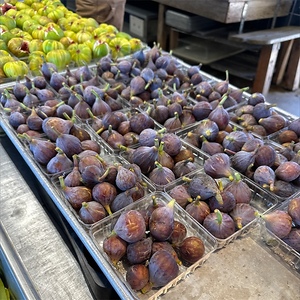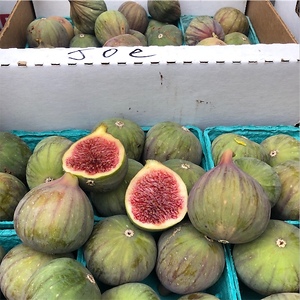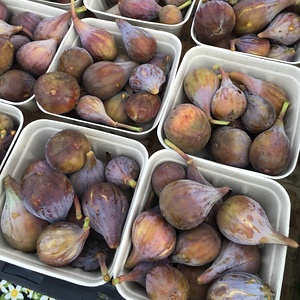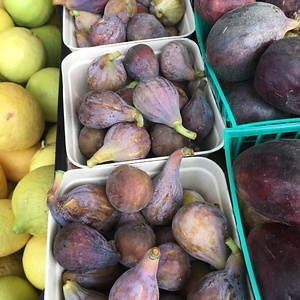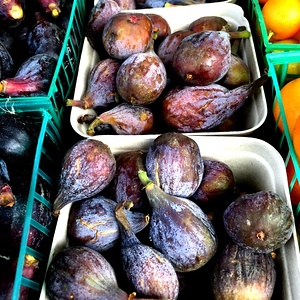


Celeste Figs
Estimated Inventory, bskt : 0
Description/Taste
Celeste figs are a medium-sized fruit with smooth, light brown to violet colored skin. They have a classic fig shape with a slender stem, tapering neck, and squat bottom. The underside of the fruit has a very small, tightly closed hole or “eye” which prevents fruit rot from bugs and moisture entering the fruit. Celeste figs boast a pastel pink flesh that appears to be heavily speckled with tiny seeds. These “seeds” are actually unfertilized fruit ovaries which give the fig its subtle resin like taste. Also known as the Sugar fig, the flesh of the Celeste fig has a rich, honey sweet flavor. When ripe and ready to harvest the Celeste fig will begin to droop and may even split slightly. The milky sap of the Celeste fig tree is skin irritant for some people, to prevent irritation wear gloves and long sleeves when harvesting fruit or pruning trees.
Seasons/Availability
Celeste figs are available twice a year, once in early summer and again late summer through the early fall.
Current Facts
Celeste figs, scientifically known as part of Ficus carica, are a member of the Moracea family and also referred to as Blue Celeste, Sugar, and Celestial. Culinarily they are used as a fruit, botanically speaking the sweet internal flesh of the fruit is actually an inverted flower and the skin of the fig, the flower’s stem tissue. Celeste figs are known as a common fig and as such are self-pollinating, an important factor in locations where fig wasps do not exist such as the southeastern United States. As a result, the Celeste fig and its improved varieties are the most common figs grown in the southeastern United States today.
Nutritional Value
Celeste figs offer a healthy dose of dietary fiber, potassium, magnesium, flavonoids, polyphenols, and antioxidants. Figs such as Celeste are also rich in calcium offering one of the highest contents found in the edible plant world. In both their fresh and dried form figs such as the Celeste have long been used for their laxative properties.
Applications
The sweet flavor of Celeste figs makes them an ideal fig for use in dessert applications. They can be halved and grilled then served with vanilla ice cream, soft cheeses, or yogurt. Grilled Celeste figs can also be served alongside cured meats and cheeses or simply drizzled with honey, balsamic, or agave nectar. Celeste figs can be used to make savory or sweet flatbreads and tarts. Sliced Celeste fig can be used raw in salads or simply enjoyed fresh and whole as a snacking fruit. Celeste figs are also ideal for processing and can be dried, frozen, or used to make preserves. Celeste figs pair well with balsamic vinegar, port wine, cinnamon, chocolate, honey, walnuts, lamb, shallots, thyme, peach, pear, vanilla bean, cured meats such as pancetta, prosciutto, and salami, and cheeses such as goat, mascarpone, blue, ricotta, and burrata. Once harvested Celeste figs can be refrigerated but should be used within a few days as they have a short shelf life. To store for long term Celeste figs can be dried, frozen, or canned.
Ethnic/Cultural Info
There have been a handful of improved varieties of the Celeste fig created at Louisiana State University in the United States. Varieties such as o’rourke, champagne (golden hued Celeste), and tiger (giant Celeste) were all created using Celeste as a parent. These new varieties have been created to have characteristics such as improved fruit quality, less frequent fruit drop, improved hardiness, and longer harvest periods as well as to provide an increased amount of common fig tree varieties that can self-pollinate.
Geography/History
Figs are believed to be native to Western Asia and the tropical regions of the Old World Mediterranean where they have been cultivated since at least 5000 BC. Figs first made their way to Europe in the early 1500’s then to Mexico in 1560 and to Virginia in the eastern United States in 1669. Today Celeste figs grow predominately in the southeast United States and California. Celeste figs prefer full sun when growing but are known to be more cold-hardy than many other fig cultivars. Celeste fig trees are vigorous growers and are prized for being highly productive fruiters.
Recipe Ideas
Recipes that include Celeste Figs. One
Podcasts



